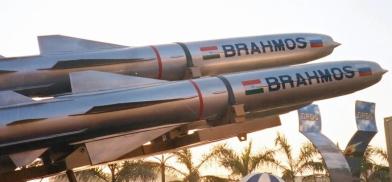With BrahMos missile, India acquires significant strike capabilities
China’s English language publication Global Times had said these "observers" - euphemism for party apparatchiks - had warned New Delhi of “new barriers” in talks related to de-escalation if India were to go ahead with the transportation of its most advanced missile to the western side of the LAC. It was also reported that China was quite riled about widening of roads on the Indian side of the LAC for the purpose of transporting heavy equipment, including BrahMos missiles.

The Indian Air Force (IAF) successfully fired the Extended Range Version of Brahmos air-launched missile against a ship target from a SU-30MKI aircraft on December 29, 2022. Launched in the Bay of Bengal region, the missile achieved the desired mission objectives. With this, the IAF has achieved a significant capability boost to carry out precision strikes from SU-30MKI aircraft against land/ sea targets over very long ranges.
The extended range capability of the missile coupled with the high performance of the SU-30MKI aircraft gives the IAF a strategic reach and allows it to dominate future battlefields, Indian military authorities have stated. The dedicated and synergetic efforts of IAF, Indian Navy, DRDO, BAPL and HAL have been instrumental in achieving this feat.
In 1998, India signed an Inter-Governmental Agreement (IGA) with Russia to design, develop, manufacture and market BrahMos through BrahMos Aerospace. The weapon was to be jointly developed by India’s Defence Research and Development Organisation (DRDO) and Russia’s NPOM, and would be launchable from land, aircraft, ships and submarines.
BrahMos is a modification of a Soviet era anti-ship missile (Oniks/ Yakhont) developed by the Reutov Design Bureau in the late 1980s. The weapon derived its name from India’s Brahmaputra and Russia’s Moskva rivers. The first test launch was conducted on June 12, 2001, at the Chandipur range in Odisha, India, and subsequently, production of the missile began at enterprises in both countries.
Development of the highly versatile, state-of-the-art tactical missile was a natural progression in India’s quest to develop various platforms and weapon systems for its military, either on its own or with a partner. The BrahMos programme thus became the first Make-in-India military venture.
Since its maiden successful test firing conducted on June 12, 2001, BrahMos has undergone a record number of nearly 100 test firings to date from land, sea, sub-sea and air platforms, validating its multifarious capability to completely annihilate high-value ground and sea-based targets with ultimate speed, pin-point accuracy and devastating firepower in all weather conditions by day and night.
Special features
One of its special features is its ability to fly extremely close to the ground to avoid missile defence systems. In fact, during the terminal phase, the missile can fly as low as 10 metres to the ground. In the final phase, the missile relies on active radar seeker or inertial guidance.
While the Indian Army started deploying the BrahMos land-attack (LACM) variant in 2007, Indian Navy inducted the versatile weapon in both anti-ship and land-attack configurations onboard its frontline surface warfare platforms from 2005 onward. In 2014, the Indian Air Force (IAF) raised the land-attack BrahMos squadron.
On November 22, 2017, the BrahMos programme achieved yet another historic milestone when the IAF successfully test-fired the advanced air-launched version (ALCM) of the weapon for the very first time from its frontline Sukhoi-30MKI strike fighter against a sea-surface target in the Bay of Bengal, thereby creating history and making India the first and only country in the world to complete the “supersonic cruise missile triad.”
Sharing an important design/production aspect with this author, BrahMos Aerospace Chief General Manger (Marketing & Promotion) Praveen Pathak said, “The air-launched variant had to be made 500-kg lighter than the land/naval variants. One of the major challenges DRDO scientists had to overcome was the optimisation of transfer-alignment inertial sensors. Thankfully, the experience of the IAF flight test crew and the dedicated and synergistic efforts of the IAF, DRDO and HAL (Hindustan Aeronautics Ltd.) ensured that the integration was smooth. Altogether, it proved India’s ability to undertake such a complex (weapon-platform) integration on its own.”
Deployment of the BrahMos missile has been a constant irritant to Chinese Communist Party-Peoples Liberation Army combo. In November 2021 it was reported that Chinese "observers" expressed deep concern over the news of India locating BrahMos missiles along the Line of Actual Control (LAC). China’s English language publication Global Times had said these "observers" - euphemism for party apparatchiks - had warned New Delhi of “new barriers” in talks related to de-escalation if India were to go ahead with the transportation of its most advanced missile to the western side of the LAC. It was also reported that China was quite riled about widening of roads on the Indian side of the LAC for the purpose of transporting heavy equipment, including BrahMos missiles.
(The writer, a former Indian Army spokesperson and author of China Bloodies Bulletless Borders, can be contacted at wordsword02@gmail.com)









Post a Comment